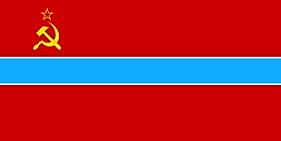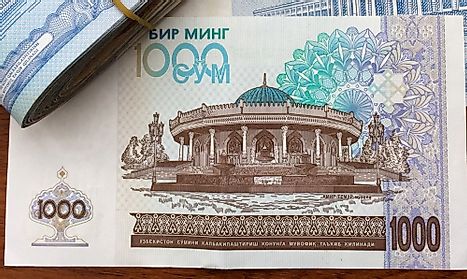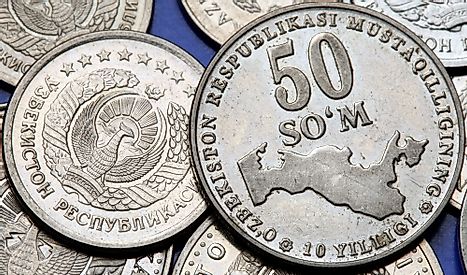Flags, Symbols & Currency of Uzbekistan
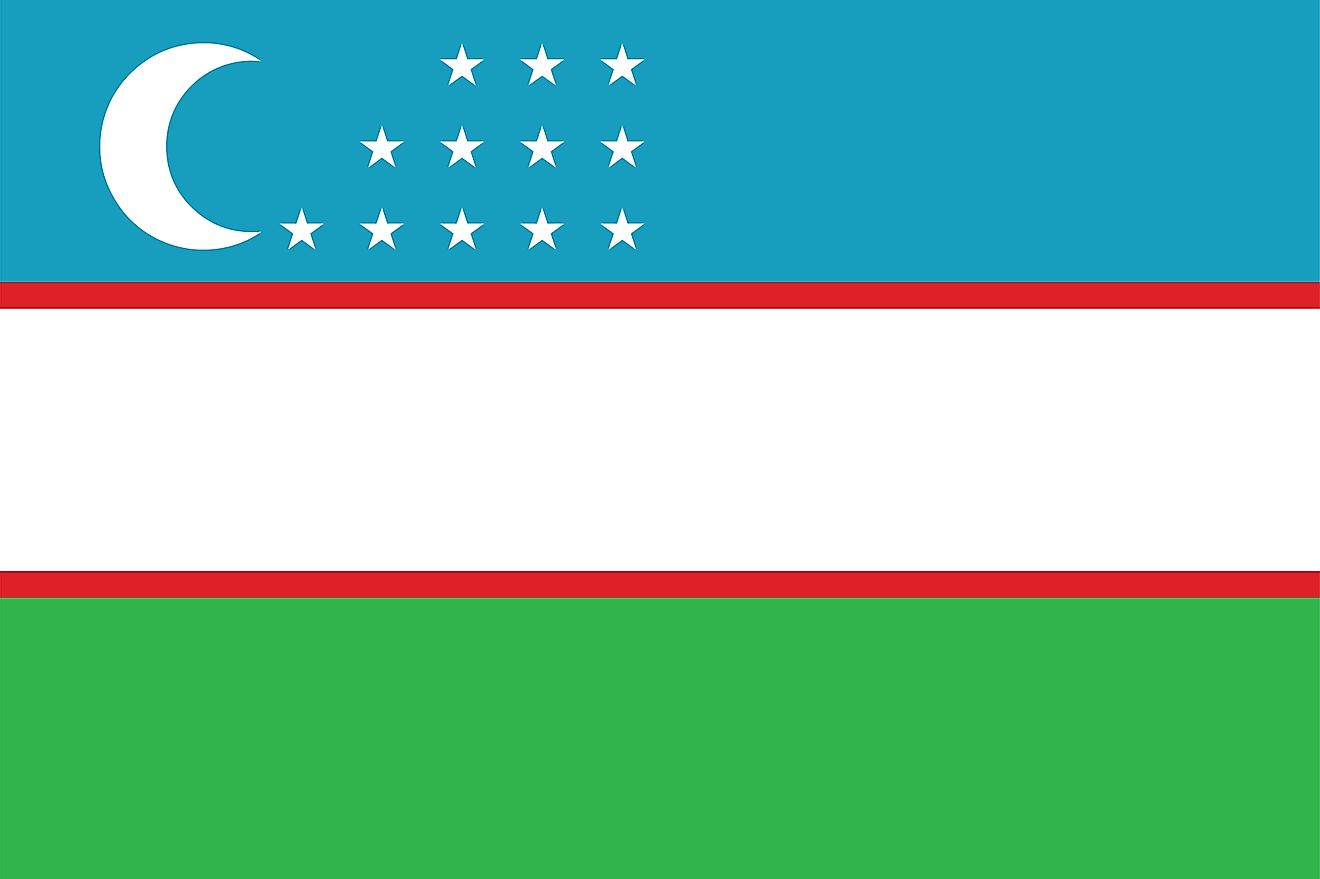
The National Flag of Uzbekistan was officially adopted on November 18, 1991.
The National Flag of Uzbekistan is a multi-colored rectangular flag featuring three equal horizontal bands of blue (top), white, and green. The middle white band is divided from the upper and bottom band by a thin red stripe on either side. Towards the left of the blue band is a vertical, white crescent moon and 12 white, five-pointed stars shifted to the hoist on the top band. The stars are arranged in three rows. The top row has three stars, the middle one has four while the bottom row has the remaining five stars. The white color signifies peace and the striving for purity in thoughts and deeds. The blue color is representative of the sky and water and is also inspired by the flag of Timur who ruled over present-day Uzbekistan in the 14th century. The green color represents nature and all its bounty. It also recognizes the dominant Muslim religion in the state. The two red fimbriations represent the vital force of all living organisms that links good and pure ideas with the eternal sky and with deeds on earth. The independence and rebirth of Uzbekistan from colonial clutches are symbolized by the crescent-shaped moon on the blue stripe. It also represents Islam and the holy month of Ramadan, where the Muslims rely on the crescent moon (“hilal”) as a signal for them to start fasting. The twelve stars next to the moon have two symbolic meanings: they represent the twelve months that are in the Islamic year as well as the twelve symbols of the zodiac. The 12 stars are arranged on the flag in such a manner that they visually allude to the “Allah” inscription in the Arabic script. The flag has a width-to-length proportion ratio of 1:2.
History of the Flag of Uzbekistan
The design of the current flag has been inspired by the colonial flag that represented the Uzbek Soviet Socialist Republic in 1952. The colonial flag under Soviet rule had three colors: where red is the dominant color with two thick red bands sandwiching a thinner blue band with a white border. This flag also had a crossed hammer and sickle that was placed below a star in the canton. The red color, sickle, hammer, and star are all Soviet Union’s symbols; while the blue color represented the sky; the white border color represented the cotton industry. After the fall of the Soviet Union and the independence of Uzbekistan, a national contest was held to chose the flag design. More than 200 entrants made their submissions which were evaluated by a special commission that was created for the purpose. An extraordinary seating of the Uzbek Supreme Soviet finally picked the winning design on November 18, 1991.
Symbols of Uzbekistan
The National Coat of Arms of Uzbekistan
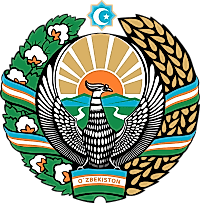
The current official National Coat of Arms/ Emblem of Uzbekistan was adopted July 2, 1992. The emblem features a mythical bird - khumo (Huma) with outstretched wings in the center. This bird symbolizes happiness, peace, and love for freedom. The outstretched wings of the khumo enclose a scenery depicting the rising sun over the mountains overlooking green pastures. The Amu Darya and Syr Darya rivers are depicted behind the khumo. The khumo is bordered on the left by a cotton plant - symbolizing the country’s agriculture and industry. On the right are ears of wheat – symbolizing the wealth and prosperity of the country. Both of them together are intertwined with a ribbon bearing the colors of the national flag. This represents the peace and unity of the different ethnic groups residing within the country. The star of Rub El Hizb is displayed at the top. It has a white star and a crescent moon symbolizing the religion of Islam. At the base of the cotton and wheat borders, a banner bearing the colors of the national flag is placed, that displays the Nation’s name in a Latinised script (Oʻzbekiston).
National Motto
The Strength is in The Justice! (Uzbek: Kuch adolatdadir! / Куч адолатдадир!)
National Anthem
- Anthem Title: "Oʻzbekiston Respublikasining Davlat Madhiyasi" ("The State Anthem of the Republic of Uzbekistan")
- Music Composer: Mutal Burhonov
- Lyricist: Abdulla Oripov
- Date of Adoption: December 10, 1992
"Oʻzbekiston Respublikasining Davlat Madhiyasi" ("The State Anthem of the Republic of Uzbekistan") is the national anthem of Uzbekistan. The music of the anthem have been composed by Mutal Burhonov. The lyrics of the anthem have been authored by Abdulla Oripov. The anthem was officially adopted on December 10, 1992.
"Oʻzbekiston Respublikasining Davlat Madhiyasi" (Uzbek)
Serquyosh, hur oʻlkam, elga
baxt, najot,
Sen oʻzing doʻstlarga
yoʻldosh, mehribon –
mehribon!
Yashnagay to abad ilmu
fan, ijod,
Shuhrating porlasin toki bor
jahon!
Oltin bu vodiylar — jon
Oʻzbekiston,
Ajdodlar mardona ruhi
senga yor!
Ulugʻ xalq qudrati joʻsh
urgan zamon,
Olamni mahliyo aylagan
diyor!
Bagʻri keng oʻzbekning
oʻchmas iymoni,
Erkin, yosh avlodlar senga
zoʻr qanot, zoʻr qanot!
Istiqlol mashʼali, tinchlik
posboni,
Haqsevar, ona yurt, mangu
boʻl obod!
Oltin bu vodiylar — jon
Oʻzbekiston,
Ajdodlar mardona ruhi
senga yor!
Ulugʻ xalq qudrati joʻsh
urgan zamon,
Olamni mahliyo aylagan
diyor!
"The State Anthem of the Republic of Uzbekistan"
My sunny free land, happiness and
salvation to your people,
You are a warmhearted companion to
your friends, to your friends!
Flourish forever with learning and
creativity,
May your glory shine as long as the
world exists!
These golden valleys – dear
Uzbekistan,
The courageous spirit of your
ancestors is with you!
When the great power of the people
raged,
(You did) have charmed the
world(land)!
The faith of an open-hearted Uzbek
does not die out,
The young free generation is a strong
wing for you, strong wing for you!
Beacon of independence, the
guardian of peace,
Lover of truth, Oh motherland,
flourish forever!
These golden valleys – dear
Uzbekistan,
The courageous spirit of your
ancestors is with you!
When the great power of the people
raged,
(You did) have charmed the
world(land)!
The Currency of Uzbekistan is the Uzbekistani soʻm
The current official currency of Uzbekistan is Uzbekistani soʻm (UZS). The currency name means “pure” or "pure gold” in the Turkic languages. The Central Bank of the Republic of Uzbekistan is in charge of issuing the currency.
Coins
Currently, coins in denominations of 50, 100, 200, 500 soʻm are in circulation.
The first soʻm had no coins. Coins were only released in two series for the second soʻm, which was introduced on July 1, 1994. The Cyrillic script and the Latin script were used for writing on the coins of the first and the second series, respectively. The second series included coins in denominations of 1-, 5-, 10-, 25-, 50-, and 100-soʻm. The 1-soʻm coin is made of stainless steel and the 5-so'm coin of brass-clad steel, while the 10-, 25-, 50-, and 100-soʻm coins are made of nickel-clad steel. The observe of the coins features the Coat of arms while the reverse features a map of Uzbekistan.
Banknotes
Currently, Banknotes in denominations of 1000, 5000, 10,000, 50,000 and 1,00,000 soʻm are in circulation.
Uzbekistan suffers from a high rate of inflation which is a sensitive issue in the country. The high inflation rates forced the Uzbeks to carry large amounts of banknotes for payments in their everyday lives including grocery shopping and bill payments. This situation caused great inconvenience to the people of the country. Thus, the government of Uzbekistan was forced to issue higher denomination banknotes of 50,000 and 1,00,000 soʻm.
Historical Currencies of Uzbekistan
Uzbekistan was part of the former Soviet Union and declared its independence from the Union in 1991. For a while after its independence, Uzbekistan continued to use the Soviet/Russian ruble as its currency. On November 15, 1993, Uzbekistan launched its currency, the soʻm. The currency was launched as a transitional currency and only banknotes were issued. There were no subdivisions of the soʻm but the denominations on the banknotes ranged from as low as 1,3, and 5 to as high as 5,000 and 10,000. The notes also had a rather simple design with the obverse side featuring the coat of arms and the other side depicting the Sher-Dor Madrasah. A year later, on July 1, 1994, a second soʻm was launched in Uzbekistan. The currency now had subdivisions where one soʻm was equal to 100 tiyin. When compared to the previous soʻm, 1,000 old soʻm was equal to 1 new soʻm.
